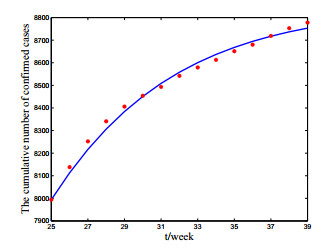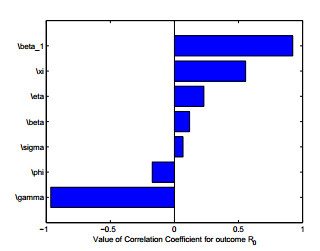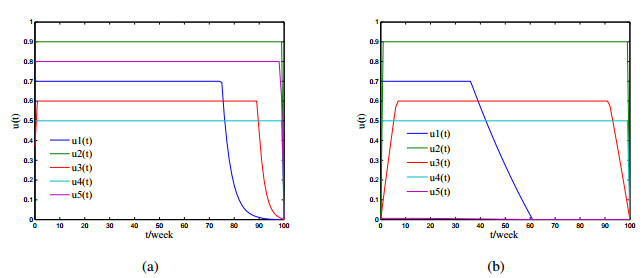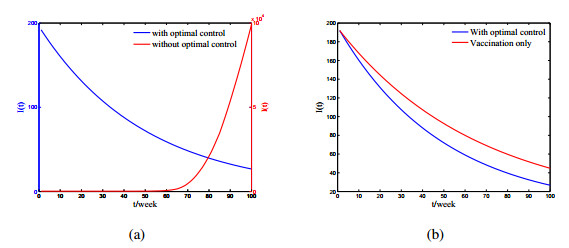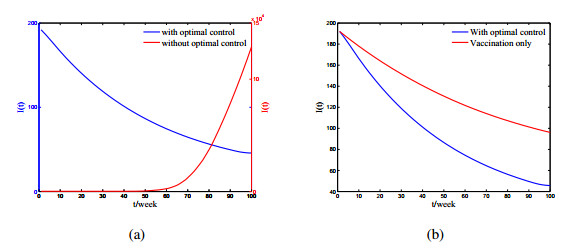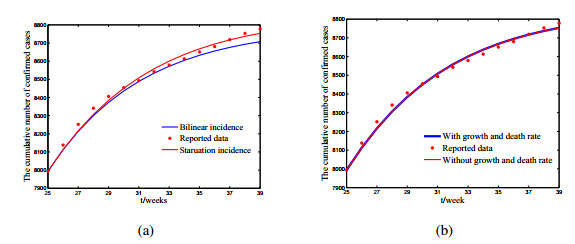1.
Introduction
Cholera is a waterborne disease caused by Vibrio cholera [1]. It is well known that it can spread rapidly in countries without clean drinking water and developed public health infrastructure [2,3,4]. In 2017, Somalia faced one of the largest outbreaks in history, with 78,784 suspected cases, including 1,159 related deaths. A year later, the number of suspected cases and related deaths reported in Somalia fell due to improved disease surveillance and case management. However, a new cholera outbreak in Somalia began in January 2019 [5].
For cholera, the interaction between environment and human is the most common pathway of transmission, that is, human typically is infected by ingesting water or food contaminated by vibrios from the environment [6,7,8]. On the other hand, close contacts with infected individuals (such as shaking hands and hugging) can also cause human infection, which indicates that the transmission route of human-to-human also exists [9]. A number of studies have shown that human-to-human transmission has a great impact on human infection that can not be ignored [10,11,12].
In 2010, Tien et al. formulated a model with multiple pathways [13]. It was assumed that the incidence rate is bilinear, indicating that the incidence rate increases with the number of infected individuals and the concentration of vibrio in the environment. However, for environment-to-human transmission, considering the fact that the inhibition effect from behavioral changes of susceptible individuals and the swarming effect of vibrios, the bilinear incidence rate is unreasonable. In 2011, based on the work in [13], by introducing a saturation incidence rate $ \beta_{1}B /(K+B) $ to describe the inhibition effect, in [9], Mukandavire et al. analyzed the following model:
where $ S $, $ I $ and $ R $ stand for the densities of the susceptible, infected and removed individuals, respectively, and $ B $ stands for the concentration of V. cholera in contaminated environment. The parameter $ \mu $ denotes the natural birth and death rates of human, $ \beta $ and $ \beta_{1} $ are the transmission rates of human-to-human and environment-to-human, respectively, $ K $ is the pathogen concentration that yields 50% chance of catching cholera, $ \gamma $ denotes the recovery rate, $ \xi $ is the contribution rate of each infected individual to the concentration of V. cholera shedding from infected individuals and $ \delta $ is the net death rate of V. cholerae.
In 2010, WHO recommended the oral vaccines should be used in areas with endemic cholera [14]. Subsequently, a number of cholera models with vaccination strategy have been proposed and analysed [15,16,17]. In 2015, Posny et al. proposed a new cholera model consisting of vaccination [18]. Model analysis shows that the vaccine can effectively control the spread of cholera. However, vaccine protection is not permanent. The existing oral cholera vaccine (OCV) can provide > % continuous protection, lasting for 2 years in the epidemic population [14].
Motivated by the works of the WHO report [14] and Posny et al. [18], in this paper, we focus on the influence of multiple pathways, imperfect vaccination on cholera infection, and analyze the following model:
where $ V $ stands for the density of vaccinated individuals. Vaccination rate of susceptible individuals is $ \phi $, vaccine efficiency is $ \sigma $ and $ 1/\eta $ is the duration of vaccine protection. And other parameters have the same biological meanings as in system (1.1).
The initial condition of system (1.2) is
and we can obtain that all solutions of system (1.2) remain positive for all $ t \geq 0 $.
The organization of this paper is as follows. In Section 2, we show the existence of feasible equilibria. In Section 3, we establish the global stability of each of feasible equilibria of system (1.2) by constructing Liapunov functions. In Section 4, we consider the optimal control problem of cholera model with vaccination, quarantine, treatment and sanitation control strategies. In order to determine the optimal control strategy, we use Pontryagin's minimum principle. In Section 5, the model is used to fit the real disease situation of cholera outbreak in Somalia. Besides, we analyze the sensitivity of the basic reproduction number and solve the resulting optimality problem numerically. Finally, a brief discussion is given in Section 6 to end this work.
2.
Equilibria and boundedness of solutions
For system (1.2), it is easy to conclude that there is always a disease-free equilibrium $ E_{0}(S_{0}, V_{0}, 0, 0, 0) $, where
Below, we first calculate the basic reproduction number $ R_{0} $ by using the method of the next generation matrix [19]. Let
Computing the Jacobian Matrix at $ E_{0} $, we have
It follows that
We obtain:
If $ R_{0} > 1 $, system (1.2) has a disease-free equilibrium $ E_{0}(S_{0}, V_{0}, 0, 0, 0) $ and an endemic equilibrium $ E^{*}(S^{*}, V^{*}, I^{*}, B^{*}, R^{*}) $, where
here
and $ B^{*} $ is the positive real root of the equation $ h(B) = 0 $, where
in which
Note that $ \lim_{B\rightarrow+\infty}h(B) = +\infty $, $ h(0) = b_0 < 0 $ if $ R_{0} > 1 $, in this case, system (1.2) has a positive equilibrium $ E^{*} $.
Let $ N = S+V+I+R. $ Then $ \dot{N} = A-\mu(S+V+I+R)-dI \leq A-\mu N $. It follows that
Furthermore, we derive from the fourth equation of system (1.2),
We therefore conclude that the set
is positively invariant.
3.
Global stability
In this section, we study the global stability of each of the equilibria to system (1.2). The approach of proofs is to use suitable Lyapunov function.
Theorem 3.1. If $ R_{0} < 1 $, the disease-free equilibrium $ E_{0}(S_{0}, V_{0}, 0, 0, 0) $ of system (1.2) is globally asymptotically stable.
Proof. Define
Calculating the derivative of $ W(t) $ along positive solutions of system (1.2), one has
On substituting $ A = \mu S_{0}+\mu V_{0} $, $ \phi S_{0} = (\mu + \eta)V_{0} $ into (3.1), we obtain that
and $ \dot{W}(t) < 0 $ for all $ (S, V, I, B, R)\neq(S_{0}, V_{0}, 0, 0, 0) $. Therefore, by Lyapunov's stability Theorem [20], the equilibrium $ E_{0} $ is globally asymptotically stable.
Theorem 3.2. If $ R_{0} > 1 $, the endemic equilibrium $ E^{*}(S^{*}, V^{*}, I^{*}, B^{*}, R^{*}) $ of system (1.2) is globally asymptotically stable.
Proof. Define
Calculating the derivative of $ W_{1}(t) $ along positive solutions of system (1.2), one has
On substituting
into (3.2), we have
and $ \dot{W_{1}}(t) < 0 $ for all $ (S, V, I, B, R)\neq(S^{*}, V^{*}, I^{*}, B^{*}, R^{*}) $. Therefore, by Lyapunov's stability Theorem [20], the equilibrium $ E^{*} $ is globally asymptotically stable.
4.
Optional control strategies
We consider the optimal control problem of cholera model with vaccinate, quarantine, treatment and sanitation control strategies:
Where $ u_{1}(t) $ is a vaccination strategy aimed to the susceptible individuals; $ u_{2}(t) $ is a quarantine strategy that can reduce the transmission of human-to-human; $ u_{3}(t) $ is another kind of quarantine strategy that can reduce the transmission of environment-to-human; $ u_{4}(t) $ is therapeutic treatment aimed to the infected people, $ u_{5}(t) $ is a sanitation strategy aimed at killing vibrios in contaminated water.
Define a control function set as $ \textbf{U} = \{u_{i}(t)\mid i = 1, \cdots, 5\}, $ and $ \textbf{X} = (S, V, I, B, R). $ The admissible trajectories of set $ \mathcal{\textbf{X}} $ are given by
Define
where $ u_{imax}\; (i = 1, \cdots, 5) $ denote the upper bounds for the efforts of vaccination, quarantine strategy, another kind of quarantine strategy, treatment and sanitation, respectively.
The objective functional
The function $ g $ is called the running payoff function [20]. The objective of the optimal control problem is to minimize the objective functional
The first question that must be addressed is the existence of the optimal control pair. According to the Filippov-Cesari existence theorem [20], we obtain the following result.
Theorem 4.1. There exists a $ \boldsymbol{U}^{*}(\cdot) $ such that the objective functional in (4.2) is minimized.
To apply Pontryagin's minimum principle [21], we need to introduce the adjoint vector function $ \lambda(t) = (\lambda_{S}(t), \lambda_{I}(t), \lambda_{V}(t), \lambda_{B}(t), \lambda_{R}(t)), $ to define the Hamiltonian:
The adjoint functions must satisfy
That is,
with transversality condition
Moreover, the characterizations of the optimal controls are based on
In order to explore the sensitivity of the cost function to the optimal control solution, we consider two different cost functions for the running payoff function $ g(\textbf{X}(t), \textbf{U}(t)) $. If we choose the running payoff function
where $ C_{i1}(i = 1, \cdots, 5) $ are the weight constants for the control strategies. The $ C_{11}u_{1}^{2}/2 $, $ C_{21}u_{2}^{2}/2 $, $ C_{31}u_{3}^{2}/2 $, $ C_{41}u_{4}^{2}/2 $, $ C_{51}u_{5}^{2}/2 $ define the appropriate costs function associated with these controls [20]. We can obtain that
In addition, if we choose another running payoff function
where $ C_{i2}(i = 1, \cdots, 5) $ are the weight constants for the control strategies. $ C_{12}\left(u_{1}(t)+u_{1}(t)^{2}\right) $, $ C_{22}\left(u_{2}(t)+u_{2}(t)^{2}\right) $, $ C_{32}\left(u_{3}(t)+u_{3}(t)^{2}\right) $, $ C_{42}\left(u_{4}(t)+u_{4}(t)^{2}\right) $, $ C_{52}\left(u_{5}(t)+u_{5}(t)^{2}\right) $ define the appropriate costs function associated with these controls [23]. We can obtain that
Where $ \lambda_{Sj}, \lambda_{Vj}, \lambda_{Ij}, \lambda_{Bj}, \lambda_{Rj}(j = 1, 2) $ satisfy the equations (4.3) and (4.4). Based on this fact, we obtain $ \widetilde{u}_{ij}(i = 1, \cdots, 5, j = 1, 2) $. Further, we have
Next, in Section 5, we apply the forward-backward sweep method to solve it numerically [15,20].
5.
Numerical simulations
In this section, system (1.2) is used to fit the real disease situation of cholera outbreak in Somalia. Besides, we analyze the sensitivity of $ R_{0} $. As mentioned in Section 4, the optimal control problem needs to be solved by numerical simulation, we will show the numerical result. In addition, we list the values of parameters in Table 1.
5.1. Data fitting
In this subsection, we use system (1.2) to fit the real disease situation of cholera outbreak in Somalia. The new cholera outbreak in Somalia began in January 2019, and the first round of oral cholera vaccination (OCV) activity started on June 22, 2019, the 25th week of 2019, so our numerical simulation starts from the 25th week of 2019.
In addition, the data we obtained is the cumulative number of cases since December 2017, so our initial case number is 7,994 [22]. By using the Markov Chain Monte Carlo method, we can get fitting results (see Figure 1). It is shown that the solutions of system (1.2) are in good agreement with the actual cholera cases, which verifies the rationality of the model established in this paper.
5.2. Sensitivity analysis
In this subsection, we use the Latin hypercube sampling (LHS) method to analyze the sensitivity of $ R_{0} $ [24]. Through the analysis of LHS samples, we obtain the Partial Rank Correlation Coefficients (PRCC) with respect to $ R_{0} $ (see Figure 2). It is easy to see that $ \beta_{1}, \xi, \eta, \beta, \sigma $ are positive correlative variables with $ R_{0} $; and $ \phi, \gamma $ are negative correlative variables with $ R_{0} $.
5.3. Optimal control solution
In this subsection, we will show the optimal control results. Based on empirical values, we set $ u_{1max} = 0.7, u_{2max} = 0.9, u_{3max} = 0.6, u_{4max} = 0.5, u_{5max} = 0.8 $, respectively. Meanwhile, we assume that the costs for vaccination, treatment, quarantine and sanitation per unit of time is roughly the same.
We first consider the running payoff function $ g_{1}(\textbf{X}(t), \textbf{U}(t)) $. The following set of values for the cost parameters
The optimal control solution is shown in Figure 3(a). The vaccination strategy $ u_{1}(t) $ can be reduced 80 weeks later from the beginning of the cholera break, and the quarantine strategy $ u_{2}(t) $, treatment strategy $ u_{4}(t) $ and sanitation strategy $ u_{5}(t) $ should be maintained in the whole process. Another quarantine strategy $ u_{3}(t) $ should be gradually increased over 1 weeks and maintained at a high level until 90 weeks.
Next, we consider the running payoff function $ g_{2}(\textbf{X}(t), \textbf{U}(t)) $. The following set of values for the cost parameters
Similarly, the optimal control solution is shown in Figure 3(b). The vaccination strategy $ u_{1}(t) $ can be reduced 40 weeks later from the beginning of the cholera break, and the quarantine strategy $ u_{2}(t) $, treatment strategy $ u_{4}(t) $ should be maintained in the whole process. Another quarantine strategy $ u_{3}(t) $ should be gradually increased over 10 weeks and maintained at a high level until 90 weeks. In addition, the sanitation strategy $ u_{5}(t) $ is not recommended.
As shown in Figure 3, the values obtained on the optimal control analysis is sensitive to the selected cost function. Therefore, there are different optimal control measures when considering different cost functions. Further, based on the optimal control measures, we can get the effects of the control strategies for the infected individuals. In order to make a comparison, we consider the effects of without any control measures (see Figure 4(a), Figure 5(a)). It is well known that vaccination is a effective measure for cholera prevention and control in a short term. In the following, we explore the influence of vaccine control alone for the infected individuals (see Figure 4(b), Figure 5(b)). By Figure 4 and Figure 5, we can conclude that combining multiple control strategies are most likely to yield the best results in fighting cholera, and the vaccine has a significant control effect on cholera.
Therefore, with sufficient costs, vaccination should be combined with other prevention and control strategies to achieve better control in complex emergencies and endemic areas, as recommended by WHO in 2010. With limited costs, only vaccination strategy can control cholera to a great extent. Therefore, vaccination strategy is a feasible and effective method for countries such as Somalia and Yemen with high cholera prevalence and poor economy.
6.
Discussion
In this paper, a cholera infection model with vaccination and transmission pathway has been discussed. Here, the total human population is divided into four subpopulation such as susceptible individuals, infected individuals, recovered individuals and vaccinated individuals. In addition, the vibrios in contaminated environment is introduced in the model. Furthermore, the global asymptomatic stability of the disease-free equilibrium and the endemic equilibrium have been completely established by using the Lyapunov's Stability Theorem. If $ R_{0} < 1 $, the disease-free equilibrium is globally asymptomatically stable. If $ R_{0} > 1 $, the endemic equilibrium is globally asymptomatically stable.
In our paper, we consider the saturation incidence rate to describe the environment-to-human transmission way of cholera. However, if the incidence rate is considered as traditional bilinear, the system (1.2) becomes:
In the following, we use the system (6.1) to fit the number of cases in Somalia from 25 to 39 weeks in 2019, and the parameter values obtained are shown in case 1 of Table 2. Further, the fitting results of systems (1.2) and (6.1) are shown in Figure 6(a). By calculating, we obtain the sum-of-squares error of system (1.2) is 6493.4, and that of system (6.1) is 16822. Therefore, it could be more practical to consider the saturation incidence rate to describe the environment-to-human transmission pathway to some extent.
If we remove the growth and death rate, the system (1.2) becomes:
The parameter values are shown in case 2 of Table 2, and the results of system (1.2) and system (6.2) are shown in Figure 6(b). From Figure 6(b), we see that there is a small difference in our fitting results. Further, by calculating, we obtain that the sum-of-squares error of system (6.2) is 6481.3, which is close to system (1.2). The reason is that in the 14 weeks of fitting, the growth and death changes of individuals can be ignored. However, the threshold that determines whether a disease is prevalent changes with the growth and death rate. Compared with system (6.2), our model can more accurately describe the spread of cholera, and have more realistic representations of biological cholera infection.
Acknowledgment
The authors wish to thank the reviewers and the Editor for their careful reading, valuable comments and suggestions that greatly improved the presentation of this work. This work was supported by the National Natural Science Foundation of China (Nos. 11871316, 11801340, 11371368), and the Natural Science Foundation of Shanxi Province (Nos. 201801D121006, 201801D221007).
Conflict of interest
All authors declare no conflicts of interest in this paper.









 DownLoad:
DownLoad:
